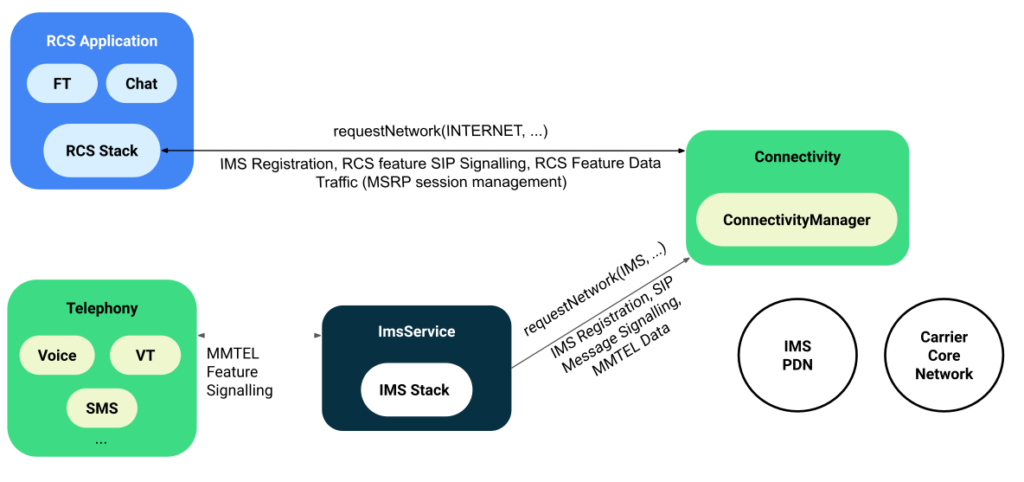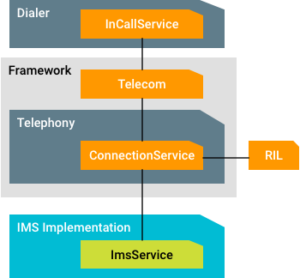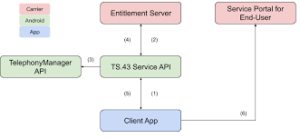Bringing IMS functionality to Android: a gateway to advanced networking
What is the role of IMS?
The IMS (IP Multimedia Subsystem) functionality is still an important backbone in Android smartphones, although it may not be something the average person thinks about every day Essentially, IMS is a custom program enabler provides the IP multimedia functionality. Imagine the invisible power that makes modern communication—such as voice calls over LTE (VoLTE) and Rich Communications Services (RCS), including video calling and enhanced messaging—possible and easy They can’t do not exaggerate its importance; Without IMS, the leap from traditional voice calls and SMS to a richer, more integrated communication experience on your Android device simply won’t be possible.
Indications of IMS service issues
How do you know when this invisible but vital service is facing a crisis? Symptoms may include, but are not limited to, not being able to make or receive VoLTE calls, not being able to send or receive messages, or even using certain carrier-related features Occasionally, you may experience issues regularly related to the availability of IMS services, or you will encounter associated errors . These symptoms are more than minor problems; Your device’s main connection is supposedly disconnected.
A snapshot of the solution
Don’t worry. While IMS service issues can seem daunting, there are many ways to diagnose and fix them. This blog post will delve into the most common issues users may encounter and provide solutions ranging from simple restarts and configuration checks to advanced troubleshooting steps Whether you are a tech newbie or Android lover, you by the end of this post Will have a solid understanding of how to ensure that your IMS service is working properly, keeping your calls, texts and multimedia messages flowing uninterrupted . Stay tuned, as we take the mysteries out of the IMS implementation and help you restore and improve your networking experiences
5 Signature Your Android needs the attention of the IMS user
The IMS (IP Multimedia Subsystem) functionality on your Android device plays an important role in the smooth and effective communication. However, like any technology, problems can sometimes be encountered. Here are five signs that your device might need some IMS project attention.
Sign #1: Frequent Call Drops or Call Quality Issues
Experiencing frequent call drops or poor call quality, like crackling sounds or distorted audio, can be a strong indicator of problems with the IMS service. These issues often arise due to:
- Weak signal strength, which makes it hard for your phone to maintain a stable connection
- Network congestion, where too many users try to access the service simultaneously, leading to overloaded networks
While these problems could be temporary, persistently facing them should prompt a deeper look into your IMS service functionality.
Sign #2: Unable to Send or Receive Text Messages (SMS/MMS)
A clear sign that your IMS service might be struggling is when you can’t send or receive text messages, whether they are SMS (Short Message Service) or MMS (Multimedia Messaging Service). Here’s why:
- SMS: These are standard text messages that don’t include images or videos. IMS issues can prevent these messages from being sent or received because IMS facilitates the seamless delivery of these texts over modern network technologies.
- MMS: These messages include media content like pictures and videos. Since MMS requires a data connection to send and receive, any disruption in IMS service, which manages IP-based communications, can lead directly to difficulties with MMS delivery.
Sign #3: Stuck on “Connecting” or “Registering” During Calls
One frustrating experience that users may encounter is when their calls repeatedly get stuck on “Connecting” or “Registering.” This issue often points to problems with the IMS service. Here’s what typically happens:
- The screen displays “Connecting” or “Registering” but never completes the call.
- Users find themselves unable to proceed with the call, leading to increased frustration, especially during urgent situations.
This sign suggests that the IMS service, responsible for managing your calls over newer, more efficient networks, isn’t functioning correctly, preventing call setup from completing.
Sign #4: “Not Registered on Network” Error Message
Receiving a “Not Registered on Network” error message can be both confusing and worrying. This error indicates that your phone is having trouble connecting with your mobile carrier’s network, a connection that is essential for both calls and texts. Here’s what you might experience:
- An immediate inability to make or receive calls and send or receive text messages.
- This error can pop up unexpectedly, leading to potential communication blackouts.
Such an issue suggests that there might be a deeper problem with the IMS service’s registration or connectivity with the network, requiring swift troubleshooting.
Sign #5: Issues with Using Carrier Services Like VoLTE or Wi-Fi Calling
IMS service is not just about traditional calls and texts. It’s the backbone for next-gen communication technologies like VoLTE (Voice over LTE) and Wi-Fi calling, offering clearer, more reliable call quality and the ability to use your phone even in areas with poor cellular coverage, as long as there is Wi-Fi. The inability to use these features can be a telltale sign of IMS service issues:
- Experiencing dropped calls when supposedly connected to Wi-Fi calling.
- Noticing that your phone does not switch to VoLTE when it should, sticking with older, less efficient calling technologies.
How to Fix IMS Service Issues on Android
When you encounter IMS service issues on your Android device, it can disrupt your ability to communicate effectively. Fortunately, there are several steps you can take to potentially resolve these problems. This guidance is divided into basic and advanced troubleshooting steps to make it as straightforward as possible.
Basic Troubleshooting Steps
Before diving into more complex solutions, it’s wise to start with some basic troubleshooting steps that can resolve minor glitches with the IMS service.
Restart Your Phone
- Why It Helps: Restarting your phone can resolve a multitude of issues by refreshing your device’s software and clearing temporary glitches, including those affecting the IMS service.
- How to Do It: Simply hold down the power button on your phone, select “Restart,” and wait for your device to reboot.
Check for Software Updates
- Why It’s Important: Manufacturers often release software updates that include bug fixes and improvements to your phone’s functionality, including the IMS service.
- How to Check: Go to “Settings,” then “About Phone,” and select “Software Update” to check if any updates are available for your device.
Toggle Airplane Mode On/Off
- Why It Works: Toggling Airplane Mode disconnects and then re-establishes your connection to the network, which can sometimes clear up IMS-related issues.
- Steps to Follow: Swipe down from the top of the screen to access the quick settings panel and tap the airplane icon to enable it. Wait a few seconds, then tap the icon again to disable Airplane Mode.
Advanced Troubleshooting Steps (Optional)
If the basic troubleshooting steps don’t resolve the IMS service issues, you may need to try more advanced methods.
Reset Network Settings
- What It Does: Resets all network-related settings to their default state, which can fix issues related to connectivity, including IMS service problems.
- Important Consideration: This action will erase saved Wi-Fi networks, passwords, and Bluetooth connections.
- How to Perform: Navigate to “Settings,” find “System,” select “Reset Options,” and then choose “Reset Network Settings.”
Contact Your Carrier
- Why This Step: Sometimes, IMS issues can be specific to a carrier’s network, requiring specialized support.
- How to Proceed: Reach out to your carrier’s customer service for assistance. They can offer further diagnosis and potentially deploy fixes specific to their network that can resolve your IMS service issues.
Frequently Asked Questions (FAQs) About IMS Service on Android
As users navigate their Android device’s IMS service, certain questions frequently arise. This section aims to address those queries in a clear and direct manner.
Q: What is IMS Service, and Why is it Important?
The IMS (IP Multimedia Subsystem) service is a key component in modern mobile networks. It allows your Android device to make calls, send text messages, and use advanced services like VoLTE (Voice over LTE) and Wi-Fi calling. In simple terms, it ensures that your mobile communication functions efficiently and effectively.
Q: Can I Permanently Disable IMS Service?
While it is technically possible to disable the IMS service, it’s generally not recommended. Disabling the IMS service can result in an inability to make or receive calls and text messages, especially those made over modern networks like VoLTE. Before resorting to disabling this service, try troubleshooting the issue or contact your carrier’s customer service for support.
Q: I’m Still Having Issues After Trying These Fixes. What Should I Do?
If you’ve attempted both the basic and advanced troubleshooting steps without success, your next step should be to contact your mobile carrier’s customer service. They can provide further assistance and potential fixes that are specific to their network.
Q: Is There a Way to Prevent IMS Service Issues?
There’s no surefire way to completely prevent IMS service issues, but some measures can reduce the likelihood. Keep your software updated to benefit from latest bug fixes and improvements. Additionally, refrain from tampering with network-related settings unless necessary. These practices can support the healthy operation of your Android device’s IMS service.
conclusion
The IMS service plays an important role in the day-to-day operation of an Android device. It provides seamless, efficient communication through advanced calls, texts and web features to ensure this user is healthy and active.
When issues arise, basic and detailed troubleshooting steps from restarting your phone to finally contacting your carrier’s customer service can often fix these issues Updating software new to avoid unnecessary changes in network settings, can help reduce your chances of encountering IMS service issues.
Your experience and connections are invaluable. Feel free to share your thoughts and questions in the comments section. Your insights not only enrich this discussion but may prove helpful to other Android users facing similar IMS usage issues.








More Stories
Is Device Health Services Spying on You? The Truth Revealed!
What is AppHub Requests Are Processing on Android? Swift Solutions to Fix It Now
SCPM Client vs. Traditional Methods: Revolutionizing Supply Chain Performance